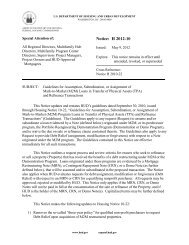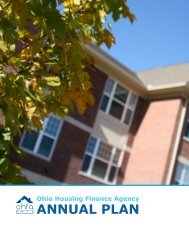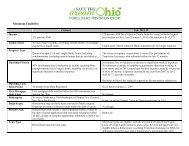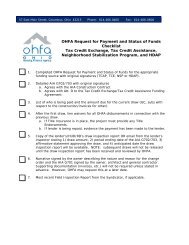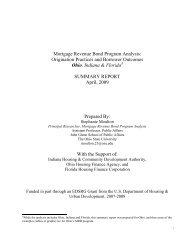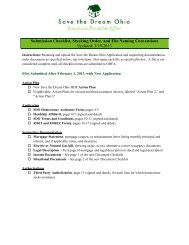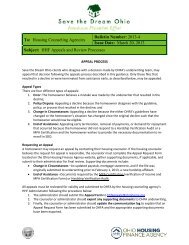lis 217 stemming the tide - LISC
lis 217 stemming the tide - LISC
lis 217 stemming the tide - LISC
- No tags were found...
Create successful ePaper yourself
Turn your PDF publications into a flip-book with our unique Google optimized e-Paper software.
The reaction to HUD's proposal was almost uniformlynegative. Advocates feared <strong>the</strong> potentialloss of affordable units. Owners, investors, andbondholders worried that withdrawal of longstandingfederal supports and uncontrolledmortgage sales or debt reduction would spurmassive foreclosures and create huge owner taxliabilities due to relief from mortgage indebtedness.Above-Market Properties: Mark-to-MarketIn 1997, Congress adopted <strong>the</strong> MultifamilyAssisted Housing Reform and Affordability Act(MAHRA) to address <strong>the</strong> problem of expiringSection 8 contracts in HUD-insured propertieswith above-market rents. MAHRA estab<strong>lis</strong>hed aMark-to-Market program with a decidedly morepreservation-oriented flavor.In general, HUD was mandated to reduceabove-market rents when <strong>the</strong> contracts expired,to restructure <strong>the</strong> underlying debt, and to renewproject-based subsidies in most cases. TheHUD-insured mortgage would be bifurcated intosupportable and unsupportable debt, with HUDretaining a deferred second mortgage in <strong>the</strong>amount of <strong>the</strong> restructured, unsupportabledebt.In exchange for debt restructuring, owners wererequired to renew <strong>the</strong>ir Section 8 contracts,subject to appropriations, for 30 years. The programalso created adjunct long-term use restrictionsin case subsidies became unavailable.HUD was directed to designate ParticipatingAdministrative Entities (PAEs) to execute <strong>the</strong>debt restructuring, with state and local publicagencies receiving preference over privateagencies. The PAEs were accountable to <strong>the</strong>Office of Multifamily Housing AssistanceRestructuring (OMHAR), a quasi-independentoffice within HUD. PAEs were charged with creatinga process that minimized costs to <strong>the</strong>mortgage insurance fund while ensuring longtermpreservation of affordable housing properties.The most innovative feature of <strong>the</strong> Mark-to-Market program—<strong>the</strong> bifurcated mortgagestructure—addressed a number of stakeholderconcerns. Since <strong>the</strong> unsupportable debt wasnei<strong>the</strong>r relieved nor forgiven, <strong>the</strong> IRS was ableto issue a favorable ruling to owners, whichminimized <strong>the</strong> risk of adverse tax consequencesfrom restructuring. HUD's continuing role assecond mortgage holder facilitated <strong>the</strong> accountabilityand long-term public control desired bypreservation advocates. The overall structureprovided a mechanism to secure a direct federalcapital subsidy for <strong>the</strong> housing, which wouldreduce annual Section 8 obligations and becost-effective over time—similar, ironically, to<strong>the</strong> discarded preservation capital grant program.Implementation of <strong>the</strong> Mark-to-Market programhas been slow. PAEs received <strong>the</strong>ir first assignmentsas late as July 1999. Due to rising rentsand <strong>the</strong> generally robust housing marketnationwide, <strong>the</strong> number of properties eligiblefor debt restructuring is much smaller than originallyanticipated. Many properties can absorb<strong>the</strong> relatively small rent decreases necessary tobring rents down to market without reducing<strong>the</strong>ir existing debt. Owners typically prefer this"OMHAR Lite" option, which involves less oversightand no use restrictions.OMHAR’s relationship with <strong>the</strong> public sectorPAEs has been a challenge. More private PAEshave been selected to administer Mark-to-Market than was originally anticipated, andmany public PAEs have left <strong>the</strong> program overtime. Of <strong>the</strong> 42 state housing finance agenciesthat were originally approved as PAEs, only 22remain in <strong>the</strong> program today.Over 2,102 properties were in <strong>the</strong> Mark-to-Market pipeline, with 1,461 transactions completedas of April 9, 2002. 6 Of <strong>the</strong>se, only 627are full debt restructurings, while 571 are"lites." Non-renewal of Section 8 has been recommendedin only 16 properties to date. Thepipeline is heavily concentrated in <strong>the</strong> heartland—Ohio,Pennsylvania, and Kentucky—although nearly every state has eligible properties.Although some owners have been willing tocooperate in <strong>the</strong> restructuring process, recentOMHAR initiatives have provided incentives tochapter one: Subsidized Housing Preservation: An Historical Perspective5



